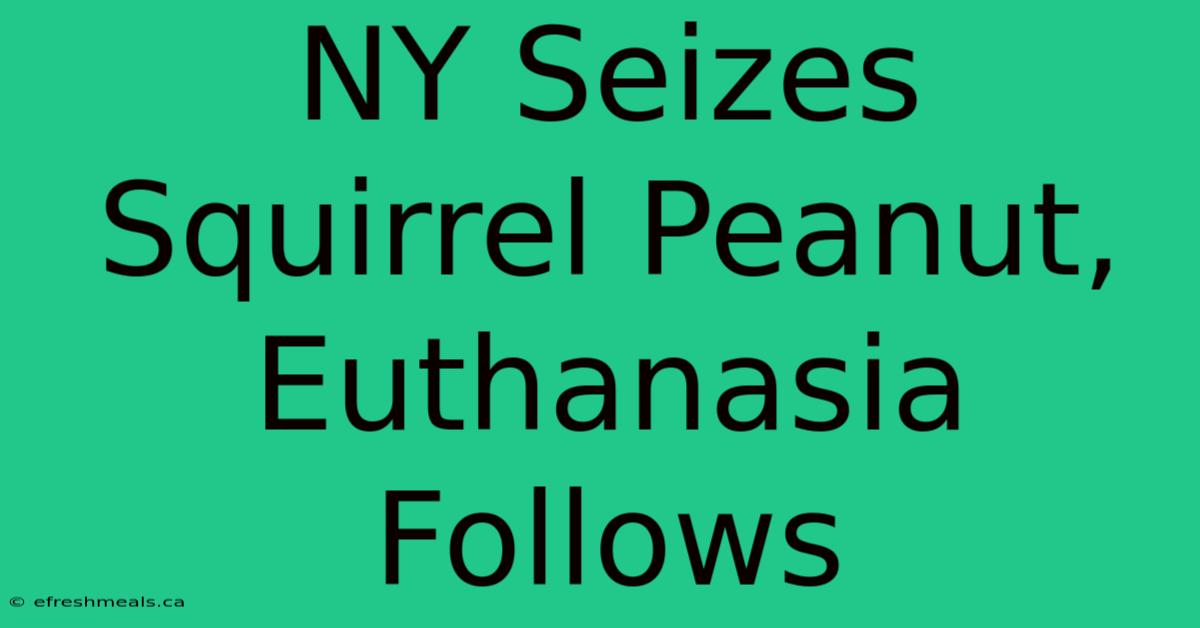NY Seizes Squirrel Peanut, Euthanasia Follows

Discover more detailed and exciting information on our website. Click the link below to start your adventure: Visit Best Website nimila.me. Don't miss out!
Table of Contents
A Peanut, A Squirrel, and a City's Dilemma: When Public Safety Meets Wildlife
Editor's Note: The recent incident in New York City involving a squirrel and a peanut has sparked conversation about the city's approach to wildlife management.
Why It Matters: This incident underscores the complexities of urban wildlife management and the need for responsible interaction with wild animals. While the city aims to protect both its citizens and wildlife, balancing these priorities can be challenging. The event has prompted discussions on the ethical considerations of euthanasia in animal control, the role of public education, and the potential impact of human intervention on wild animal behavior.
Key Takeaways:
| Takeaway |
|---|
| The incident raises concerns about the city's policy on euthanasia for wildlife. |
| Public education on responsible wildlife interaction is crucial. |
| The incident highlights the delicate balance between public safety and wildlife. |
The Incident
The incident occurred in Central Park, where a squirrel was found holding a peanut in its mouth. The peanut was confiscated by a park ranger, leading to the squirrel's subsequent euthanasia. This decision, made on the grounds of potential public health risks, has drawn significant attention.
Public Health Concerns
The city's concern centered around the potential for the peanut to contain harmful substances that could affect the squirrel's health and potentially be transmitted to humans. The city's wildlife management protocols prioritize public health and safety, even if it means resorting to euthanasia in extreme cases.
The Euthanasia Decision
The decision to euthanize the squirrel was based on a combination of factors, including the potential public health risks and the difficulty in safely removing the peanut from the squirrel. The city's wildlife management protocols are designed to minimize the risk of disease transmission and ensure public safety.
Public Response
The incident has sparked considerable debate, with some advocating for more humane alternatives to euthanasia, such as tranquilization and peanut removal. Others have defended the city's decision, emphasizing the need for public health protection.
The Ethical Dilemma
The incident has highlighted the ethical challenges of urban wildlife management, particularly in cases involving euthanasia. Striking a balance between public safety and animal welfare is a complex issue that requires careful consideration.
The Role of Public Education
The incident emphasizes the importance of public education on responsible wildlife interaction. Feeding wild animals can lead to habituation, making them more comfortable around humans and potentially increasing the risk of human-wildlife conflict.
The Future of Wildlife Management
The incident has prompted calls for a review of the city's wildlife management policies, particularly regarding euthanasia. It has also underlined the need for public education and ongoing research to better understand the complex dynamics between humans and wildlife in urban environments.
FAQ
Q: Why did the city euthanize the squirrel? A: The city's primary concern was public health, specifically the potential for the peanut to contain harmful substances that could affect the squirrel's health or be transmitted to humans.
Q: What are the alternatives to euthanasia? A: Alternatives include tranquilization and attempts to remove the peanut safely. However, the effectiveness and feasibility of these options depend on the specific circumstances.
Q: Is it safe to feed squirrels in the park? A: Feeding squirrels in the park is discouraged as it can lead to habituation and increase the risk of human-wildlife conflict. The city's wildlife management protocols advise against feeding wild animals.
Q: What steps can the city take to improve wildlife management? A: The city could review its euthanasia protocols, invest in more humane alternatives, and strengthen public education efforts on responsible wildlife interaction.
Tips for Responsible Wildlife Interaction
- Do not feed wild animals: Feeding can lead to habituation and increase the risk of human-wildlife conflict.
- Maintain a safe distance: Give wildlife space and avoid approaching or cornering them.
- Do not attempt to touch or handle wild animals: They can be unpredictable and may bite or scratch.
- Report injured or sick wildlife: Contact the local wildlife rescue organization or animal control.
Summary
The recent incident in New York City involving a squirrel and a peanut has highlighted the complex challenges of urban wildlife management. While the city aims to protect both its citizens and wildlife, balancing these priorities can be difficult. This incident underscores the need for responsible wildlife interaction, public education, and ongoing efforts to find humane solutions for managing wildlife in urban environments.
Closing Message
The incident serves as a reminder of the delicate balance between human activity and the well-being of wildlife. While the city's actions aimed to protect public health, the incident has sparked a conversation about the ethical implications of wildlife management and the need for more compassionate approaches in the future.

Thank you for visiting our website wich cover about NY Seizes Squirrel Peanut, Euthanasia Follows . We hope the information provided has been useful to you. Feel free to contact us if you have any questions or need further assistance. See you next time and dont miss to bookmark.
Featured Posts
-
Voice Authentication At Risk Ai Cloning Test
Nov 03, 2024
-
Arteta Moves On From Pgmol Gordon Goal Row
Nov 03, 2024
-
Kaine Makes Surprise Snl Appearance
Nov 03, 2024
-
Ai Voice Cloning Bank Security Concerns
Nov 03, 2024
-
Snl Welcomes Kamala Harris
Nov 03, 2024
